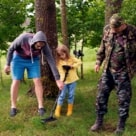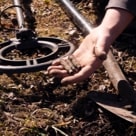The 1715 Fleet: The Archetypal Sunken Treasure
Published by Sam Jacobs on 04/07/21
The 1715 Fleet by Fred Banke
Throughout the decades, people have been lured to this coast of Florida in search of treasure from the 1715 Fleet. Treasure salvors in boats, metal detectorists on the beach have all researched the history of the fleet and the “Queen’s Jewels”. I first became interested back in the early 1990s, watching the salvor boats blowing holes in the ocean floor just off the beach at Turtle Trail. Then in the early 2000s, I purchased my first of several metal detectors from Kellyco, driving up from West Palm Beach on the weekends to hit the beaches of the Treasure Coast.
Both movies and television documentaries have been made about treasure hunting the 1715 fleet and a short film will be released in September named the “Queen’s Jewels”.
History of The 1715 Fleet
The King of Spain had sent two separate fleets to the New World, one of them being “Tierra Firme” commanded by General Don Antonio de Echeverz y Subiza which sailed to Cartagena and the other being the “New Spain” commanded by General Don Juan Esteban de Ubilla headed to Vera Cruz. They would meet in Havana and sail to Spain in a combined fleet carrying the wealth accumulated over the past three years.
Mid-March 1715, the Tierra Firme fleet arrived in Havana, heavily laden with silver and gold coins from Bogata, chests filled with emeralds from the Muzo mine, and gold jewelry from Peru. Echeverz was ready and waiting for Ubilla’s delayed New Spain fleet which was stuck in Vera Cruz awaiting the arrival of pack mule trains from Acapulco, Spain’s outlet to the Pacific. The mules would transport silk, ivory, and K’ang Hsi porcelain from the markets of Manilla and Canton which finally arrived allowing Ubilla to arrive in Havana the first week of May.

The Plate Fleet passing El Morro Fortress
After the rendezvous, they had planned to replenish stores and water and return to Spain. But urgent word had arrived from Spain, as the King had remarried, they were to wait for the Queen’s dowry, eight chests of jewelry, an emerald ring weighing 74 carats, a heart made up of 130 matching pearls, a rosary of pure coral, and many items of jewelry fashioned from gold, most of which was undocumented. These were stored in Ubilla’s personal cabin and were later to be known as the “Queen’s Jewels.” Due to the delay, it became the death warrant of the 10 ships and the 700 sailors that perished.
After delays, the Plate fleet finally set sail with the morning tide of Wednesday, July 24th, slowly passing El Morro Fortress, which guarded the harbor of Havana. As a senior military officer, Ubilla would lead the convoy, Echeverz for the protection of the fleet, brought up the rear in his war galleon.
On July 29th the wind had calmed, but the swell had grown stronger, by the next morning, they had been at sea a week. By afternoon the winds had picked up and by nightfall had reached 70 knots. Waves crashing over the decks carrying away cargo. By nightfall, the winds were gusting at over 100 knots, above the sound of the winds, the sound of the breakers on the reefs which line the Florida coast, could be heard. The fleet was scattered, all were resigned to shipwreck.
Antoine Dare, the captain of the Griffon, a French ship that had joined the fleet to return to Europe, had played a hunch and steered off to the East of the original course allowing room for the weather, it would be the only ship to survive.
By dawn July 31st, 1715 all eleven of the Spanish ships had wrecked, some capsized in deep water, others broke apart on the reefs and one ship washed ashore intact.
Wreckage and bodies were scattered for 30 miles along the Florida coast. The Spanish attempted to salvage the treasure until 1719 with only 30% recovered dealing with the hazards of sharks, Indians, and Buccaneers, it proved too much for them.
Seven hundred lives and more than 14 million pesos in the registered treasure were lost in one of the worst maritime disasters of all time.
Treasure Hunting The 1715 Fleet: The Beginning
It all began back in 1948 when a building contractor named Kip Wagner was walking along the beach South of Sebastian Inlet when he found 7 Spanish silver coins. He then borrowed a metal detector and over the next several months discovered another 40 coins. In 1949 he spent the summer trying to salvage a wreck site off the beach with a dragline to pull ashore fragments of wood, metal spikes, ships fasteners, a cannon carriage, unbroken bottles, and a Spanish copper coin, maravedis dated 1649.
During the next ten years, he continued to walk the beaches finding 100s of silver coins and non-dating later than 1715. Wagner later discovered the camp that the Spanish salvors made to recover the treasure after the storm, now the location of the McLarty Treasure Museum. He discovered ceramic and pottery shards, nails, musket balls, a pair of cutlasses, coins, chunks of silver, and a gold ring with six small diamonds.
Believing there was a wreck just off the beach, he made a small surfboard with a glass window to view what was beneath the surface and in the shallow water, he discovered five iron cannons. Returning with dive equipment he located more cannon, anchors, and a cluster of silver coins fused together. After discovering another wreck site North of Ft Pierce inlet with piles of ballast stones, Wagner then formed a team of divers and an owner of a 21 ft boat to begin salvage work on the site. After recovering a few thousand silver coins, the team formed the Real Eight Company with Wagner as president.
In mid-August 1960, 11 pure silver wedges were found and they dubbed the site the “Wedge Wreck”. In 1961, Wagner was ready to return to the Sebastian Inlet site which they dubbed the “Cabin Wreck,” finding large clumps of silver coins and hundreds of loose coins scattered over the bottom. The 1962 season brought hundreds of silver coins, artifacts including muskets, silver forks, and a silver plate. In November during a storm, Wagner and his nephew Rex Stocker went to the cabin site, Wagner found corroded silver coins, Stocker found a gold chain 11 ft 4.5 inches long with a dragon 2.5 inches long.
After hearing of the 1715 fleet finds, Mel Fisher, who had worked wreck sites off California and the Caribbean, came to Florida to meet with the Real Eight Team. He offered to join forces with the Real Eight and bring a group of professional divers to work the wrecks full time. They agreed to split what they found with the Real Eight group fifty-fifty. Fisher formed the Treasure Salvors, Inc and moved to Florida in 1963.

Gold coins found by The Treasure Salvors
The 1963 season for the Real Eight group was a rough start but ended with thousands of silver coins, a silver crucifix, a gold chain with a pendant, whole bowls, and cups later identified as K’ang Hsi china. The Treasure Salvors got off to a late start with a fifty-foot salvage vessel, starting at another wreck Wagner had located while flying down the coast, “The Sandy Point Wreck.” By Christmas, they had recovered 1,200 silver and 3 gold coins.
In 1964, using a magnetometer, the Treasure Salvors had located more wrecks and Fisher had designed the “mailbox system,” a piece of metal that would deflect propeller wash downward, forcing the clear water to the bottom, blowing away large quantities of sand. In ten feet of water, it could blow a hole 10 ft in diameter and 6 ft deep, and in 30 ft of water, the hole would be 30 ft diameter in the same amount of time.
Later came to the “prop wash,” a similar system, consisting of a metal tube bent in an elbow, which is inches wider than the propeller and points vertically toward the seafloor. The blaster is twice as efficient as the “mailbox system” although nowadays they call this the mailbox system. This system revolutionized underwater excavation and accounted for the success of the Treasure Salvors and the Real Eight over the following years.
A few miles south of the wedge wreck, they discovered another wreck dubbed the “Colored Beach Wreck”, where they recovered 6,000 silver coins, 3,500 gold coins, 2 gold discs weighing 7.5 pounds, gold chains, medallions, rings, and other jewelry. Today, the local detectorists call this “Ring Beach,” due to all of the 1715 rings found along that beach. In 1965 the Real Eight crew went full time, recovering in one week more than 50,000 silver coins, 21 silver wedges, 10 large silver discs weighing between 44 and 105 pounds.
By now both the Real Eight and the Treasure Salvors were working side by side at the wedge wreck recovering a large clump of silver coins weighing 125 pounds, sixty pounds of loose silver coins, two silver plates, and a chest containing three thousand silver coins. In 1971a young boy diving for golf balls near the Rio Mar golf course discovered another 1715 wreck where Fisher recovered $2,000,000 in treasure.
Mel Fisher went on to recover $3,000,000 in one year from the Corrigan wreck which has proved to be one of the best producing wreck sites in current times.
Mel Fisher’s maritime attorney used the English admiralty law to take possession of these wreck sites, if anyone wanted to work a site, they would have to subcontract from the Fisher family because his rights under admiralty law were grandfathered into the new federal shipwreck law. Later Fisher moved his operation to the Florida Keys, where he discovered the Atocha, but that’s another story.
In the following years, thousands of gold and silver coins and other objects were discovered from the 1715 wrecks and the rights to the wrecks were sold by the Fisher family, to the Queens Jewels, LLC owned by Brent Brisben.
300-Year Anniversary

Detecting the Corrigan’s wreck site
From July 28th through the 29th I attended the 300th Anniversary Conference on the 1715 Plate Fleet in Vero Beach, Florida. The following day, I detected the Corrigan’s wreck site. It was a hot calm day and not very productive, so I decided to walk up the beach and watch the Capitana treasure salvor boat anchored close to the beach.
It was by far the closest I had seen any boat to the shore, there was a Japanese film crew making a documentary about the treasure hunting taking place. Aboard were Brent Brisben, Captain Jonah Martinez, divers Dan Beckingham and Bill Bartlet. It didn’t take long before excitement started onboard the Capitana, gold coins were being found, Jonah came ashore with a few gold coins to show the few onlookers, me, and a few others.
Then something really amazing happened, Bill Bartlett surfaced with the first of the Royals, a special 8 Escudo, perfectly minted for the king of Spain. All of the coins found were in perfect condition, trapped for 300 years in the crevices below protected against the wave action and finally being recovered.
The 1715 Fleet by Sam Jacobs
Caesarea National Park isn’t the only place where divers have found vast riches in living memory. There’s also the 1715 Treasure Fleet (also known as the 1715 Plata Fleet — “Plata” being the Spanish word for silver), which was unearthed by an amateur diver and enterprising Florida Man, William Bartlett. He went down to do what many divers do — check out a shipwreck that is hundreds of years old. What he found was so much gold he had to start packing it into his gloves.
Over the next two days, he and his compatriots found 350 gold coins worth an astonishing $4.5 million. And while other hauls have been pulled out of this shipwreck, this one was the biggest to come from the wreck in decades.
Where Did the 1715 Treasure Fleet Come From?
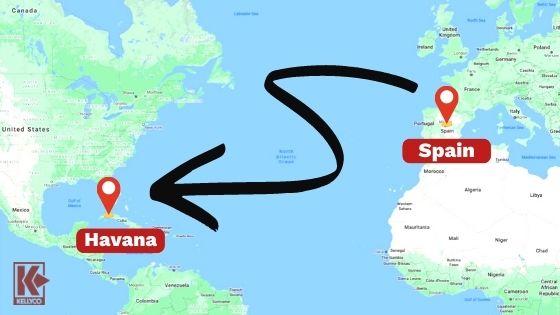
Map of route from Spain to Havana, Cuba
The story of the 1715 Treasure Fleet is almost the archetype for the American conception of “sunken treasure.” There were 11 ships, totally loaded with treasure, on their way to Spain from Havana in July 1715. The Spanish were badly in need of the gold, as they had just ended the War of Spanish Succession over who would be King of Spain — the French claimant or the Austrian one — and the war badly drained their resources.
Of course, July is prime hurricane season in Florida, then as it is now and the Spanish did not have the advanced meteorological equipment that we have today for early storm detection. As many as 1,500 Spaniards died in the wreck and it was one of the biggest disasters of the entire Spanish colonial era. Some of the men survived and established a camp while they awaited rescue. The Survivors’ and Salvagers’ Camp can still be visited today, on Orchid Island, Florida.
The Spanish sent ships and, to their credit, were able to recover about 80 percent of what was on board the ships. This is astonishing, not just because of the relatively limited technology of the time, but also because of the number of pirates mulling around the area trying to score whatever treasure they could. Indeed, famed pirate Henry Jennings was first accused of piracy because of his lurking about trying to recover the lost gold of the 1715 Treasure Fleet.
But the remaining 20 percent sat in the deep for quite a long time indeed. It took over 250 years before anyone was able to unearth anything that sank during that shipwreck. All told, there were 14 million pesos on the entire fleet.
Mel Fisher and Kip Wagner: Modern-Day Treasure Hunters
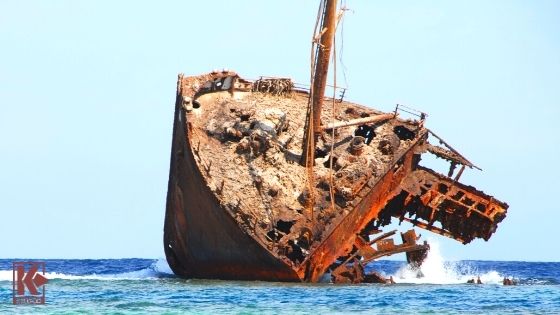
Shipwreck. Red Sea.
Mel Fisher and Kip Wagner were treasure hunters who teamed up with the intention of getting the remaining bits of treasure still in the deep waters off the Florida coast. Two ships in the massive wreck were located and it took five years of work to uncover all that they could from just those two ships alone. After they moved onto other projects, various salvage crews worked the area until 1983.
The Queens Jewels were allegedly on the ship, though these have not, as of yet, recovered. What’s more, the cargo estimates are based on what was registered with the Spanish crown. There is reason to believe that a far greater amount of riches were on the ship in the form of contraband that the captains and their crew were smuggling back for their own personal enrichment, not that of the Spanish crown.
Unlike some of the other unearthed hoard we have covered here, such as the Hoxne Hoard or the Staffordshire Hoard, there is a clear owner of the shipwreck: Queens Jewels, a salvaging company that acquired the rights to the area in 2010 from the previous owner, treasure hunter Mel Fisher, who came out on top in a long and contentious court battle against the State of Florida. The Spanish government did not attempt to exert a claim on the shipwreck.
For its part, the State of Florida is entitled to 20 percent of any haul, which is then transferred to a museum in Tallahassee. Whatever is left is then split between Queens Jewels and the lucky treasure hunter. It can easily cost $50,000 to even get to the point where you can begin digging around in the ocean for this gold. Anything that washes ashore is the exclusive property of the person who found it. The 1715 Treasure Fleet is one of the reasons the Treasure Coast in Florida is such a popular place for metal detecting, particularly after hurricanes.
Eric Schmitt’s Million-Dollar Score
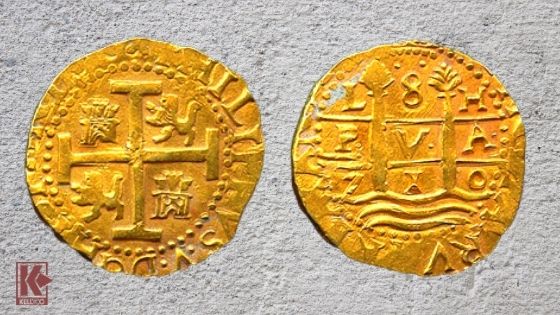
Rare 8 Escudos Lima dated 1710 recovered from the 1715 Fleet
While Bartlett is one of the biggest scores in recent history, he’s not by any means the only person to strike gold in the deep blue sea thanks to the 1715 Treasure Fleet. Eric Schmitt and his family were able to unearth 52 gold coins and 40 feet of gold chain, as well as 110 silver coins and buttons, which amounted to over a million dollars in value.
Schmitt dives a lot and it wasn’t his first trip down to the Treasure Fleet looking for his fortune. Usually, however, by his own reporting, all he’s able to come up with is empty holes and beer cans. This time, however, it was vastly different. Only 15 feet down, but 1,000 feet offshore, he was able to strike it rich. A gold coin popped out of the sandbank he was working on. It wasn’t the only coin he would uncover and one of them, a very rare piece called a Tricentennial Royal, was worth $500,000.
Back in the old days, people who made coins weren’t terribly concerned with how they looked. The main concern was about how much they weighed and what the overall purity of the precious metal was. The Royals, however, were an exception, as they were presented directly to the king himself and had to be of exquisite quality.
The 1715 Treasure Fleet has seen some exposure in pop culture. A scene in the video game Assassin’s Creed IV: Black Flag involved the 1715 Treasure Fleet. The first season of the Starz series Black Sails revolves around the 1715 Treasure Fleet and attempts by pirates to recover the riches that it left on the ocean floor.
It is estimated that there are still $400 million in Spanish gold coins outstanding in the area known as Florida’s Treasure Coast. That’s a lot of gold and silver just sitting around for the right enterprising diver to happen upon it.
